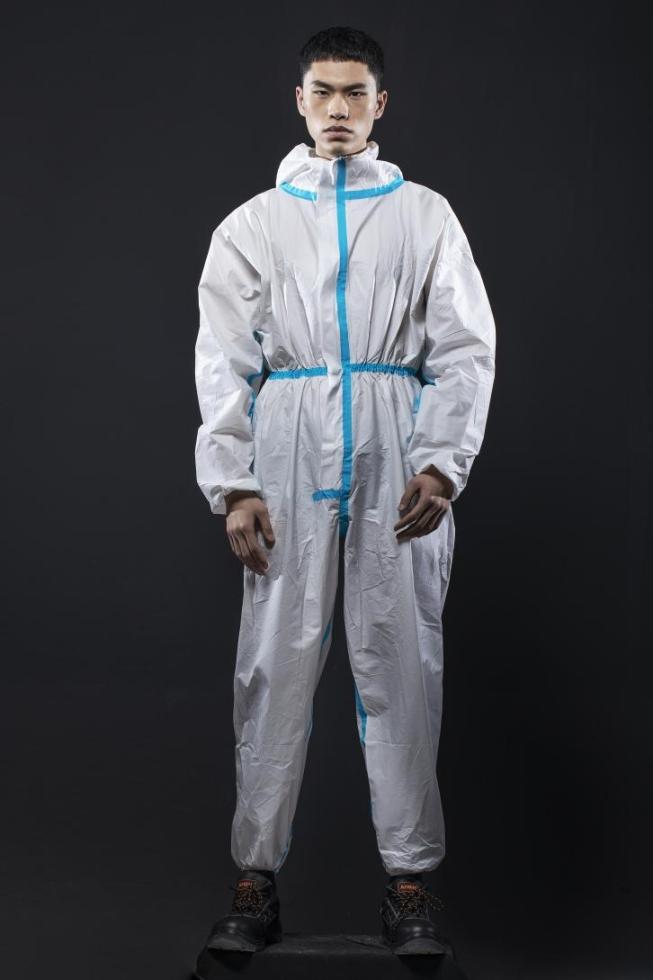The Vitality of Chemical Protective Clothing
Chemical Protective Clothing (CPC) is specialized apparel designed to shield wearers from hazardous substances, including toxic chemicals, corrosives, and biological agents. Essential for ensuring safety in high-risk environments, CPC is a critical component in preventing occupational exposure to dangerous materials. Industries such as chemical manufacturing, pharmaceuticals, healthcare, and emergency response frequently rely on CPC to protect their workforce from harm. Andanda, at the forefront of workplace safety innovation, leverages cutting-edge digital technology to enhance its PPE offerings. Through dedicated research and development, Andanda crafts tailored protective solutions, establishing a comprehensive PPE ecosystem that addresses diverse needs and delivers customized, high-quality protective gear to its clientele.

Types of Chemical Protective Clothing
Chemical Protective Clothing (CPC) is an essential defense line in environments with hazardous substances. The type of CPC required varies depending on the nature of the chemicals, the type of exposure, and the work conditions. Here’s an overview:
Fully Encapsulating Suits
Designed for maximum protection, these suits cover the entire body, including a self-contained breathing apparatus (SCBA) to protect against airborne substances. Ideal for highly hazardous environments where skin or respiratory exposure can lead to serious harm.
Chemical-Resistant Suits
These suits are resistant to a wide range of chemicals and are used in scenarios where full encapsulation is not necessary. They provide a good balance between protection and mobility, suitable for tasks with splash risks rather than vapor exposure.
Gloves and Footwear
Specifically designed gloves and boots protect against chemical penetration and degradation. Material selection—nitrile, latex, neoprene, or butyl—is critical based on the chemical resistance required.
Eye and Face Protection
Goggles, face shields, and full-face respirators protect against splashes, mists, and vapors that pose risks to the eyes and mucous membranes. The choice depends on the hazard and the level of exposure.
Comparison and Selection Criteria
Selecting the right CPC involves evaluating the chemical hazard, form of the chemical (liquid, gas, particulate), potential exposure routes (skin, inhalation), and work conditions (temperature, confined space). Compatibility charts and permeation data are invaluable resources for making informed decisions.
Standards and Regulations
Ensuring the safety and efficacy of CPC requires adherence to international and national standards and regulations.
International Standards
ISO (International Organization for Standardization) and EN (European Standards) provide guidelines for CPC, including testing methods for chemical resistance, permeation, and degradation. For example, ISO 13982-1 specifies requirements for protective clothing against solid particulates.
U.S. Standards
The Occupational Safety and Health Administration (OSHA) and the National Institute for Occupational Safety and Health (NIOSH) set standards in the U.S. OSHA’s Hazardous Waste Operations and Emergency Response (HAZWOPER) standards, and NIOSH’s certification for respirators are critical benchmarks for CPC.

Compliance and Certification Processes
Manufacturers must rigorously test their products to comply with relevant standards, often involving third-party laboratories. Certification assures end-users that the CPC meets the necessary protection levels against specific hazards.
Role of Standards in Ensuring Safety and Quality
Standards ensure that protective clothing provides a reliable level of safety and performance. They help employers and workers select appropriate CPC, fostering a safer working environment and reducing the risk of occupational injuries.
Understanding Chemical Hazards
A comprehensive understanding of chemical hazards is pivotal in selecting appropriate CPC and ensuring workplace safety.
Types of Chemical Hazards
Chemicals can pose toxic, corrosive, and flammable hazards. Toxic chemicals can cause acute or chronic health effects, corrosives can damage skin or eyes, and flammables pose a risk of fire or explosion.
Routes of Chemical Exposure
Exposure can occur through inhalation, skin contact, ingestion, or injection, with inhalation and skin contact being the most common in industrial settings. Understanding these routes informs the selection of suitable CPC.
Assessing Workplace Chemical Hazards
Assessment involves identifying chemicals used or produced, understanding their properties, and evaluating how workers might be exposed. This process is critical for selecting the right type of CPC.
Chemical Hazard Communication
Effective communication about chemical hazards is essential. Labels and Safety Data Sheets (SDS) provide vital information on chemical properties, hazards, and safe handling procedures. These tools are crucial for informing and protecting workers.
Selecting the appropriate type of CPC requires a thorough understanding of the chemical hazards present, adherence to rigorous standards and regulations, and an informed assessment of the workplace environment. By integrating these elements, organizations can safeguard their workforce against chemical exposures, ensuring their health and safety in potentially hazardous conditions.
Selection and Use of Chemical Protective Clothing
The effectiveness of Chemical Protective Clothing (CPC) is pivotal in ensuring workplace safety. The selection and use of CPC require a comprehensive approach, considering various factors related to the work environment and the hazards present.
Assessing the Work Environment and Hazard Types
The first step involves evaluating the workplace for potential chemical hazards, considering factors like the nature of the chemicals, concentration levels, and possible exposure routes. This assessment guides the selection of the most appropriate CPC.
Criteria for Selecting Appropriate CPC
Selecting the right CPC involves analyzing the material’s permeation resistance—its ability to resist chemical penetration—and degradation resistance, indicating how the material deteriorates upon chemical contact. Compatibility with the chemical hazard and the work condition are critical factors.
Training on Proper Use and Limitations of CPC
Training is essential to ensure workers understand how to correctly use CPC, including donning and doffing procedures, recognizing the limitations of their protective gear, and knowing when to replace it. This knowledge is crucial for maximizing protection.
Case Studies on Effective Use in Various Industries
Various industries provide examples of effective CPC usage. In the chemical manufacturing sector, fully encapsulating suits have prevented serious injuries during spill incidents. In healthcare, protective gowns and gloves have significantly reduced contamination risks during pandemic outbreaks.
Maintenance, Decontamination, and Disposal
The maintenance, decontamination, and disposal of CPC are critical for ensuring ongoing protection and environmental safety.
Cleaning and Maintenance Procedures for Reusable CPC
Reusable CPC requires regular cleaning and maintenance according to manufacturer guidelines to maintain its protective integrity. This often involves specific washing procedures and inspection for wear and tear.
Decontamination Methods
Decontamination methods vary depending on the chemical exposure and the type of CPC. They can range from simple washing to more complex procedures involving specific decontamination solutions to remove hazardous substances safely.
Disposal Protocols for Contaminated or Damaged CPC
Proper disposal protocols are essential for CPC that is heavily contaminated or beyond repair. This involves adhering to environmental regulations and guidelines to prevent secondary exposure or environmental contamination.
Record-Keeping and Monitoring for Safety Compliance
Maintaining records of CPC maintenance, decontamination, and disposal activities is crucial for regulatory compliance and safety audits. This documentation helps in tracking the lifecycle of protective gear and ensuring workplace safety standards are met.
Advances and Future Trends in Chemical Protective Clothing
The field of CPC is evolving, with advancements aimed at enhancing protection while improving wearer comfort and environmental sustainability.
Material Technology Advancements
New materials, such as breathable fabrics and nanotechnology-enhanced coatings, offer improved protection and comfort. These innovations reduce heat stress and increase the wearability of CPC without compromising safety.
Smart Protective Clothing Integrating Sensors and IoT
The integration of sensors and IoT technology into CPC allows for real-time monitoring of environmental hazards and the health status of the wearer, enabling immediate response to potential danger.
Environmental Considerations and Sustainable Practices
Sustainability is becoming a focus in CPC design, with an emphasis on recyclable materials and manufacturing processes that minimize environmental impact.
Anticipating Future Challenges in Chemical Safety
As chemical processes and materials evolve, so do the challenges in protecting workers from exposure. Continuous research and development in CPC are essential to stay ahead of emerging hazards and ensure the safety of workers across industries.
In Closing
The critical importance of Chemical Protective Clothing (CPC) in maintaining workplace safety cannot be overstated. As a pivotal component in the defense against hazardous chemical exposures, CPC not only safeguards the health and well-being of workers but also ensures operational continuity across various industries. Through stringent selection criteria, adherence to global safety standards, and ongoing advancements in material and technology, CPC evolves to meet the complex challenges posed by chemical hazards. Moreover, effective training, rigorous maintenance, and environmentally responsible practices enhance the protective capabilities of CPC, reinforcing its vital role. As we move forward, the commitment to improving and innovating CPC will continue to be fundamental in protecting lives and fostering a culture of safety and awareness in the face of chemical risks.

